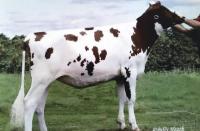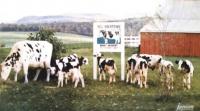Main Sections
Front Page
SportsValley VitalsIt's in the StarsStarwiseArchivesLinksAbout The VoiceContact Us
|
Spending Time With Lee And Brenda Charron

photo by provided Gathered together the Charron family pauses to smile for the camera. |
| 
photo by Billy Heath Helen the Holstein is a prime example of an excellent dairy cow that makes small farms productive and profitable.
|
| 
photo by provided Painted by Peter Langrock, this is only one of the many beautiful views on the Moody Meadows Farm in New Haven.
|
| 
photo by provided These two youngsters might seem related, but in fact it is only by marriage. Behold a young Lee (left) and a young Brenda ( right) and the curls and smiles are legendary on both!
|
| 
photo by provided Moody Meadows Farm is busy day in and out with Lee, Brenda and on the weekends grandchildren Collin and Aidan at work alongside Poppa. |
|
Tuesday June 27, 2017
By Cookie Steponaitis
The vista off Lime Kiln Road is breathtaking and many passersby pause to capture an image of the setting sun and a field of grass with picturesque Holstein grazing. While the view is worthy of being photographed daily, the image that truly captures Moody Meadows Farm and its owners, Lee and Brenda Charron is related to the words quality feed, quality care, quality cows, commitment and work ethic.
Being farmers has always been a risky business and one that connects the couple to the land, but for Lee and Brenda Charron it is even more. It was a conscious choice for the couple to own a small farm and keep farming it for the past forty years. Lee Charron grew up on a small farm and simply liked everything about it. “I liked cows even then,” explained the New Haven farmer. “I liked the smell of pure hay, working with the cows and in particular the Holstein Breed.” Charron worked as a young man for Bob Baily in Carlisle, Massachusetts and fell in love with the breed. Mentored and encouraged by Bailey, Charron began to learn about the breed and how to work with genetics to produce excellent Holsteins. While the cows on Moody Meadows Farm are working animals there is a connection that is evident between the farmer and his herd. “I was out to the barnyard just the other week showing a person something and the cows came running toward us. He was scared half to death and they were simply saying hi,” Charron chuckled.
The Charron’s had two children Kristin and Kevin when they moved to the farm in 1977. “Most people tried to talk me out of it,” explained Lee. “They told me that the farming lifestyle was not for young couples and that it brought a lot of mental stress and most couples could not make it. A small farmer would not survive.” After renting a farm from local farmer Jim Adams for next to nothing in West Haven, Vermont the couple purchased land in New Haven with the help of an FHA farm loan. Lee was active in the Local Holstein Association, held leadership roles and helped young people learn about the breed. The Charrons show some at Addison County Field Days and love the local farm community but have watched it dwindle in recent years.
It is Earl Buttes, the National Agricultural Secretary for President Richard Nixon who made the remark to the national farmers of America, “Get big or get out” in 1976 heralding the beginning of the movement for farms to become huge in order to stay cutting edge. While Charron is supportive of the decisions every farmer has to make, he holds steadfast in his conviction that the small farm can be profitable and sustainable. “Growing up on a farm teaches responsibility, how to work and also how to be a bit of a scientist, mechanic, financier, business man and cow man,” explained Charron, “but today the youth are taught that the only model that works is to go large.” Waiting in the wings to become the next generation on the land, grandchildren Aidan age 14 and Collin age 13 have been working with poppa since they were learning to walk. Charron trusts his grandsons to work with the cows whether it is operating equipment, starting milking or feeding. Every weekend the pair is on the land learning more about what it takes to own and operate a small dairy farm.
Both Lee and Brenda have turned 70 this year and admit that the farm life gets harder as you age but still would not substitute another type of life for it. Brenda grew up around animals and her father ran the Morgan Horse Farm for over thirty years and she came to the farm life knowing what to expect. “There are three main requirements to be a success with a small farm. You need quality feed, quality care and quality cows. If any of those three are not present simultaneously you will fail,” explained Lee Charron. Milking 50 cows on a 300-acre farm, Charron works diligently to get the proper feed balance for his cows and balances it all with the growing costs of repairs and the volatile price of milk. He uses this single example to explain why 99% of the U.S. population is not involved in farming, “We have a Chopper that the gear sometimes gives us a problem and you have to change it. Just a few years ago that gear cost me $85.00 and now it is $450.00. A slip gear for a piece of equipment we own cost a few years ago was $265.00. Today that same piece sells for $1125.00.”
Lee Charron has been proving people wrong for years about the capability of small Vermont farms. As early as 1982 he was being told by leaders of financial and lending institutions that he would not survive. Working with one local lending institution he found a partnership that gave him the trust to lend when needed and see him successfully pay back on the schedule allowed. Putting forty years into quality Holsteins have earned Charron success in sustaining a way of life for himself and his family, selling bulls to Japan and breeding cows that have gone on to earn excellent ratings and acclaim for their quality milk and bloodlines.
For those who do not farm, which breed of cow is prized above all else is not a matter of conjecture. While some famers prefer John Deere or Allis Chalmers for tractors and equipment, nine out of ten farmers in the nation milk Holsteins. What Charron learned long ago has held true for all these years that dairy farmers looking for more milk and quality milk raise Holsteins.
While a two-hour conversation opened the doorway into learning what life is like on Moody Meadows Farm in New Haven, Vermont it only scratched the surface of the diligence, determination, flexibility and work ethic of the Charron families and those few other small Vermont farms that cling to a way of life fading from the Vermont agricultural landscape. Son Kevin now farms in Wisconsin and two grandsons stand waiting in the wings for the opportunity to carry the farm into the next generation. What the future holds for Lee and Brenda Charron is not certain, but one thing they do know. The way of life they chose forty years ago is still the one they would choose today of being on the land with cows, each other and their family. It is a farm tradition dating back to the founding of the state and if Lee Charron has anything to say about it, a tradition that will be here when his grandchildren have grandchildren. “Small farms can make it and can be successful,” concluded the New Haven farmer. “But the lessons learned in school must include the belief and the teachings of how to run a small farm. We need our young generations coming up to have the choice to go big or stay small.”
June is National Agriculture Month and the Valley Voice honors and thanks all those who farm in the Champlain Valley for the quality food, milk and other products available for us to consume. To look at the statistics on a national scale, in 2015 $133.1 billion worth of American agricultural products were exported around the world. The United States sells more food and fiber to world markets than is imported, creating a positive agricultural trade balance. One U.S. farm feeds 168 people annually in the U.S. and abroad. Farmers and ranchers receive only 16 cents out of every dollar spent on food at home and away from home. Farm and ranch families comprise just two percent of the U.S. population yet today’s farmers produce 262 percent more food with 2 percent fewer inputs (labor, seeds, feed, fertilizer, etc.), compared with 1950. (AFBF’s Food & Farm Facts book (2015 edition)
|
Advertisements
Search our Archives
|







 Printer Friendly
Printer Friendly